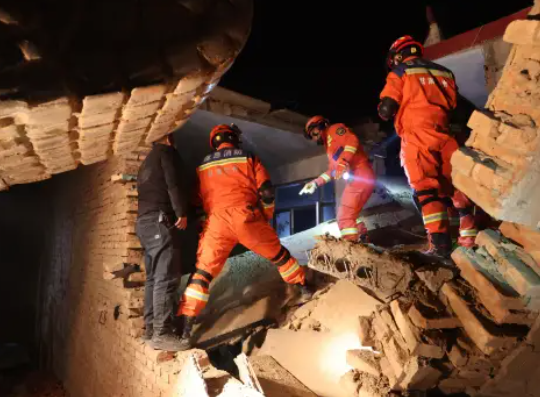Rescuers in remote villages in northwest China dug through the rubble of collapsed homes on Tuesday after China’s deadliest earthquake in years killed at least 118 people and injured hundreds more.

Officials in impoverished Gansu province said the shallow tremor just before midnight had caused the deaths of at least 105 and injured almost 400 as of Tuesday morning.
A further 13 died, 182 were injured and 20 were missing in the city of Haidong in neighbouring Qinghai province, state broadcaster CCTV reported.
The quake damaged thousands of homes — many of them ramshackle brick structures — and sent residents running into the freezing streets for safety.
“I was almost scared to death. Look at how my hands and legs are shaking,” said a woman of about 30 in a video posted to a social media account associated with the state-run People’s Daily newspaper.
“As soon as I ran out of the house, the earth on the mountain gave way, thudding on the roof,” she said as she sat swaddled in a blanket outside, cradling a baby.
Footage from CCTV showed family possessions strewn among masonry from a house that caved in during the shaking.
The quake was China’s deadliest since at least 2014, when more than 600 people died in southwestern Yunnan province.
China’s western hinterland carries the scars of frequent seismic activity, and a huge quake in Sichuan province in 2008 left more than 87,000 people dead or missing, including 5,335 schoolchildren.
The US Geological Survey said Monday night’s magnitude-5.9 quake struck at a shallow depth at 11:59 pm local time (1559 GMT) with an epicentre around 100 kilometres (60 miles) from Gansu’s provincial capital, Lanzhou.
China’s state news agency Xinhua reported the magnitude as 6.2 and said the shaking was felt as far away as the major city of Xi’an, about 570 kilometres (350 miles) away.
Dozens of smaller aftershocks followed, and officials warned that tremors with a magnitude of more than 5.0 were possible in the next few days.
A quake measured at magnitude 5.2 by USGS was detected further northwest in the Xinjiang region on Tuesday morning.
Chinese President Xi Jinping called for “all-out efforts” as search and rescue work got under way early Tuesday.
Temperatures are below freezing in the high-altitude area, and rescuers should be on guard for secondary disasters, he said, according to CCTV.
Provincial officials said at a press conference on Tuesday morning that nearly 5,000 homes had been damaged by the quake in Gansu.
State media reported that power and water supplies were disrupted in villages around the epicentre but that some electricity had later been restored.
Footage from one of the worst-hit places on CCTV showed residents warming themselves by a fire while emergency services set up tents.
CCTV said more than 1,400 firefighters and rescue personnel had been sent to the disaster zone, while another 1,600 remained “on standby”.
The broadcaster said supplies including drinking water, blankets, stoves and instant noodles were also being sent to the area.
It added that the central government had preliminarily diverted 200 million yuan ($28 million) in relief funding to “guarantee the security of people’s lives and property, and minimise the impact of losses from the disaster”.
Footage showed emergency vehicles driving along snow-lined highways towards the scene with their lights flashing.
Rescue workers in overalls were pictured shoulder-to-shoulder in the trucks, while other images showed them lining up in ranks to receive instructions.
Other clips showed emergency personnel going through debris by torchlight, unfolding orange stretchers for the casualties.
Hundreds of people have been evacuated in Gansu, officials said.
Earthquakes are not uncommon in China. In August, a shallow 5.4-magnitude earthquake struck the eastern part of the country, injuring 23 people and collapsing dozens of buildings.
In September 2022, a 6.6-magnitude quake hit Sichuan province leaving almost 100 dead.
And in 2010, a 6.9-magnitude quake in Qinghai left 3,000 people dead or missing.




